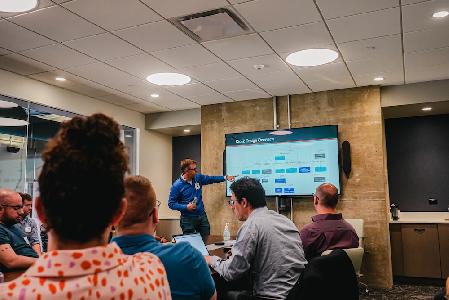
The following is a report done in partnership with Temple University’s Philadelphia Neighborhoods Program, the capstone class for the Temple Journalism Department.
In February 2010, the National Endowment for the Humanities Office of Digital Humanities awarded the Philadelphia Department of Records a Digital Humanities Startup grant to investigate the use of augmented reality applications for mobile devices.
The prototype application, AR by PhillyHistory.org, is available for free download on iPhone and Android. It allows users to view historic photographs as 3D digital information overlaid atop their current location using the camera, GPS and many other sensors that came stock with nearly all consumer smartphones.

“As a historian,” explains Project Manager Deb Boyer in an interview with Technically Philly, “I find it exciting to be able to combine the old and the new like that.”
The historic photos are among 93,000 collected by Philly History.org from the City Archives.
“We are taking advantage of this database that already exists,” said Robert Cheetham, President and CEO of Azavea, “and experimenting with different software techniques for making that visible on a smartphone.”
Watch Cheetham speak more about the project in the video below.
[vimeo 24382373 w=420 h=310]
Advancing cell phone technology is going to make AR technology more interesting, Boyer said, but that will also challenge software developers.
“One thing we found is that what might work on one phone may not work on another, so in terms of development, that is a challenge,” she said. “If you think developing between Chrome, Google and Firefox is difficult, imagine trying to switch between four or five different phones.”

Though AR technology is not a brand new concept, bringing the technology to smartphones unlocks a whole new range of possibilities and potential uses, ranging from education to improving city functioning, Cheetham explained.
“For example, imagine that a city water main had broken,” Cheetham said, gesturing with his hands, as if holding an invisible tablet and swiping it over the table of an Azavea conference room. “A technician could pass an iPad or Android tablet over the surface and see what is underground and approximately where it is located.”
“With the available sensors in smartphones—the GPS, the accelerometer, and more recently, the gyroscope—all working together, we can show things very specific to a location,” said Cheetham.

Further exploration of AR technology is at the mercy of more adequate funding, Cheetham said, but plans to develop an open source toolkit that would allow more flexibility, as well as leverage for newer sensors such as the gyroscope, are future goals with the project.
AR’s potential as a resource for fostering growth and appreciation of humanities and the arts have given it a tremendous response from members of those communities.
“It was incredible getting people excited in new ways,” said Boyer. “In some cases, it involved combining pictures that are 150 years old with technology that is barely two years old.”
Azavea’s White Paper detailing the Philly History AR application and the research and development behind it is available for free download from their website here.
Join the conversation!
Find news, events, jobs and people who share your interests on Technical.ly's open community Slack

Philly daily roundup: Student-made college cost app; Central High is robotics world champ; Internet subsidy expiration looms

Philly daily roundup: Earth Day glossary; Gen AI's energy cost; Biotech incubator in Horsham

Philly daily roundup: Women's health startup wins pitch; $204M for internet access; 'GamingWalls' for sports venues

